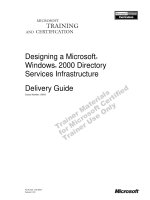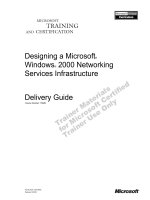Tài liệu Module 1: Microsoft® Windows® 2000 Networking Services Infrastructure Overview pptx
Bạn đang xem bản rút gọn của tài liệu. Xem và tải ngay bản đầy đủ của tài liệu tại đây (806.8 KB, 18 trang )
Contents
Overview 1
Introduction to Networking Services Design 2
Microsoft Windows 2000
Networking Services 3
Translating Organizational Goals
into a Design 10
Review 12
Module 1: Microsoft
®
Windows
®
2000
Networking Services
Infrastructure Overview
Information in this document is subject to change without notice. The names of companies,
products, people, characters, and/or data mentioned herein are fictitious and are in no way intended
to represent any real individual, company, product, or event, unless otherwise noted. Complying
with all applicable copyright laws is the responsibility of the user. No part of this document may
be reproduced or transmitted in any form or by any means, electronic or mechanical, for any
purpose, without the express written permission of Microsoft Corporation. If, however, your only
means of access is electronic, permission to print one copy is hereby granted.
Microsoft may have patents, patent applications, trademarks, copyrights, or other intellectual
property rights covering subject matter in this document. Except as expressly provided in any
written license agreement from Microsoft, the furnishing of this document does not give you any
license to these patents, trademarks, copyrights, or other intellectual property.
2000 Microsoft Corporation. All rights reserved.
Microsoft, Active Directory, ActiveX, BackOffice, FrontPage, JScript, MS-DOS, NetMeeting,
PowerPoint, Visual Basic, Visual C++, Visual Studio, Win32, Windows, Windows Media,
Windows NT, are either registered trademarks or trademarks of Microsoft Corporation in the
U.S.A. and/or other countries/regions.
Project Lead: Don Thompson (Volt Technical)
Instructional Designers: Patrice Lewis (S&T OnSite), Renu Bhatt NIIT (USA) Inc.
Instructional Design Consultants: Paul Howard, Susan Greenberg
Program Managers: Jack Creasey, Doug Steen (Independent Contractor)
Technical Contributors: Thomas Lee, Bernie Kilshaw, Joe Davies
Graphic Artist: Kirsten Larson (S&T OnSite)
Editing Manager: Lynette Skinner
Editor: Kristen Heller (Wasser)
Copy Editor: Kaarin Dolliver (S&T Consulting)
Online Program Manager: Debbi Conger
Online Publications Manager: Arlo Emerson (Aditi)
Online Support: Eric Brandt (S&T Consulting)
Multimedia Development: Kelly Renner (Entex)
Test Leads: Sid Benevente, Keith Cotton
Test Developer: Greg Stemp (S&T OnSite)
Production Support: Lori Walker (S&T Consulting)
Manufacturing Manager: Rick Terek (S&T OnSite)
Manufacturing Support: Laura King (S&T OnSite)
Lead Product Manager, Development Services: Bo Galford
Lead Product Manager: Ken Rosen
Group Product Manager: Robert Stewart
Other product and company names mentioned herein may be the trademarks of their respective
owners.
Module 1: Microsoft® Windows® 2000 Networking Services Infrastructure Overview iii
Instructor Notes
This module provides an overview of the key Microsoft
®
Windows
®
2000
networking services and outlines the network design aspects necessary to
design a networking services infrastructure. The module begins by explaining
the basic components of an infrastructure from the designer’s perspective. It
then reviews key networking technologies and how they fit into the
Windows 2000 network architecture. The module ends with an examination of
the key criteria to consider when designing a network.
At the end of the module, students will be able to:
Describe the process for designing the networking services infrastructure.
Identify the Microsoft Windows 2000 networking services that make up a
networking services infrastructure.
Describe the design aspects used to translate organizational goals into a
networking services design.
Course Materials and Preparation
This section provides you with the materials and preparation needed to teach
this module.
Required Materials
To teach this module, you need the following materials:
Microsoft PowerPoint
®
file 1562B_01.ppt
Preparation Tasks
To prepare for this module, you should:
Read all of the materials for this module.
Read the review questions and be prepared to elaborate beyond the answers
provided in the text.
Be familiar with all of the technologies discussed and be able to position
them both in terms of the overall Windows 2000 network architecture and in
terms of where they will be discussed within the course.
Presentation:
15 Minutes
iv Module 1: Microsoft® Windows® 2000 Networking Services Infrastructure Overview
Module Strategy
Use the following strategy to present this module:
Introduction to Networking Services Design
Provide a brief description of a model for designing a networking services
infrastructure.
In this section:
• Point out that this basic design process is useful for designing a network
infrastructure. At a high level, it is the process by which all networks are
designed, implemented, and managed.
• Emphasize that this model is generic in nature. Organizations typically
customize the model to suit their unique situations and design
methodologies. Avoid spending time discussing implementation and
management philosophies.
• Some students may have good methodology skills. Avoid spending too
much time on the details of the methodology and avoid getting into a
discussion about the relative merits of specific methodologies.
• In the subsequent modules, students generate their own designs and
strategies. Acknowledge that solutions may vary by student.
Microsoft Windows 2000 Networking Services
Provide an overview of Windows 2000 networking services.
In this section:
• Emphasize that this course is based on services and options available in
Microsoft Windows 2000 Advanced Server.
• Explain that Microsoft Windows 2000 server products offer a number of
distinct network technologies and services. These technologies address
specific organizational needs and have both benefits and limitations.
• Point out that designers must understand the organizational objectives to
create a networking services design that best meets these objectives.
• Avoid going into too much detail in this topic. The details come in the
modules that follow.
• This topic presents a good chance to find out how knowledgeable the
students are in each of the technologies and to identify whether students
require more background information on any given technology.
Translating organizational goals into a design
Introduce the criteria used to evaluate and refine a design.
In this section:
• Point out the aspects for grouping design decisions and explain that
these aspects are aimed at making a design process more consistent and
logical.
• Discuss each aspect and provide an example of how the aspect applies to
a design.
• Emphasize that the aspects are used in subsequent modules to analyze
and design a networking solution.
Module 1: Microsoft® Windows® 2000 Networking Services Infrastructure Overview v
Module 1: Microsoft® Windows® 2000 Networking Services Infrastructure Overview 1
Overview
Introduction to Networking Services Design
Microsoft Windows 2000 Networking Services
Translating Organizational Goals into a Design
To develop an effective networking services infrastructure, you must be able to
analyze the organizational goals and translate them into specific design
strategies.
In your networking services design, you must take into account the existing
infrastructure. You will base all of your design decisions on the existing
infrastructure. In addition, your design must be easily managed so that the
organization is able to maintain the infrastructure operation within design
specifications.
At the end of this module, you will be able to:
Describe the process for designing the networking services infrastructure.
Identify the Microsoft
®
Windows
®
2000 networking services that make up a
networking services infrastructure.
Describe the design aspects used to translate organizational goals into a
networking services design.
Slide Objective
To provide an overview of
the module topics and
objectives.
Lead-in
When you design a
networking services
infrastructure, you must
follow some general
principles that apply to most
networking scenarios.









